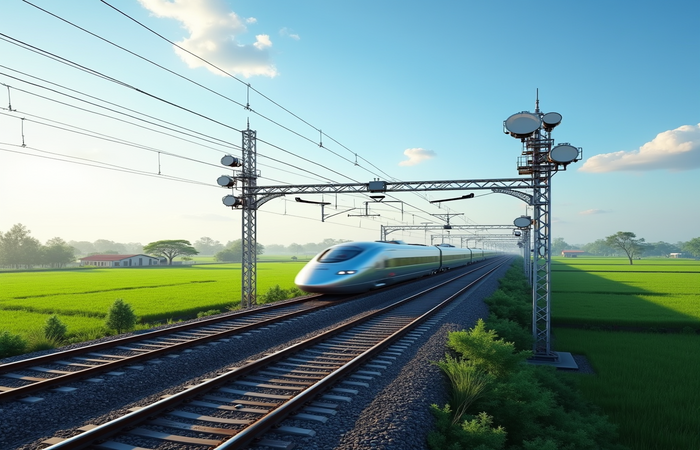Goole’s £15M Railway Innovation Center: A UK First

The Establishment of a World-Leading Railway Research Center in Goole, UK
This article explores the significant development of a new £15 million (approximately $19.6 million USD) railway research and innovation center in Goole, Yorkshire, UK. This initiative, a collaborative effort between the University of Birmingham’s Centre for Railway Research and Education (BCRRE), the University of Huddersfield’s Institute of Railway Research, and Siemens Mobility, marks a substantial investment in advancing railway technology and expertise. The center, dubbed the Centre of Excellence for Railway Through-Life Engineering, aims to revolutionize railway infrastructure through a focus on digital systems, robotics, sensing, and automation, impacting every stage of a railway asset’s lifecycle – from design to decommissioning. The project’s success hinges on a multifaceted approach, combining academic research, industry collaboration, and substantial financial commitment, reflecting a broader national strategy to bolster the UK’s railway sector. This collaborative approach is key to ensuring the center’s success in contributing to advancements in railway engineering and contributing to the overall growth of the UK rail industry. The center will be a vital resource for the development of next-generation railway systems and technologies.
A Collaborative Approach to Railway Innovation
The success of the Goole center relies heavily on its collaborative nature. The partnership between the University of Birmingham’s BCRRE (Europe’s largest specialist railway research center), the University of Huddersfield’s Institute of Railway Research, and Siemens Mobility brings together leading academic institutions and a major industry player. This synergy ensures that research directly addresses industry needs, fostering rapid innovation and technological transfer. Siemens Mobility’s commitment extends beyond financial contributions; their existing rail village in Goole provides a physical location for the center, enhancing interaction and knowledge exchange. This close proximity to Siemens’s new train manufacturing facility further strengthens the connection between research and practical application. The collaborative model ensures that the research conducted remains relevant and applicable to real-world challenges, leading to more impactful results.
Focus on Through-Life Engineering and Digital Systems
The center’s core focus is on through-life engineering (TLE), encompassing all phases of a railway asset’s lifecycle. This holistic approach contrasts with traditional, siloed approaches, enabling more efficient and cost-effective management of railway infrastructure. The emphasis on robotics, sensing, and automation represents a commitment to utilizing cutting-edge technologies to improve maintenance, safety, and overall operational efficiency. The integration of advanced digital systems is crucial to achieving these goals. The use of digital twins, predictive maintenance algorithms, and data-driven decision-making will significantly transform railway operations. This focus on TLE and digital technologies ensures that the research conducted is at the forefront of current industry trends and pushes the boundaries of current capabilities.
Strategic Alignment with National Rail Infrastructure Development
The establishment of the Goole center aligns strategically with the UK government’s efforts to upgrade and modernize its national rail network. The £15 million investment from the UK Research Partnership Investment Fund (UKRPIF) – alongside significant co-investment from the rail industry and the University of Birmingham – reflects the government’s commitment to fostering innovation and technological advancement within the sector. This initiative also supports broader goals such as the Integrated Rail Plan for the North and Midlands, and the development of High-Speed 2 (HS2) rail lines. By strengthening the UK’s railway research capabilities, the center contributes to the overall success of these large-scale infrastructure projects.
Conclusion
The creation of the Centre of Excellence for Railway Through-Life Engineering in Goole represents a landmark achievement for the UK rail industry. The £15 million investment, coupled with significant industry co-investment and a collaborative partnership between leading academic institutions and Siemens Mobility, positions the center as a global leader in railway research and innovation. The focus on through-life engineering, digital systems, robotics, sensing, and automation reflects a forward-thinking approach that addresses the complex challenges facing the modern railway sector. The strategic alignment with national rail infrastructure development initiatives ensures that the center’s research directly contributes to the UK’s broader goals of modernizing its rail network and enhancing its competitiveness on the global stage. The center’s success will not only drive technological advancements but also contribute to the development of a highly skilled workforce, securing the future of the UK’s railway sector. The center’s collaborative approach, focus on through-life engineering, and alignment with national infrastructure plans collectively ensure its long-term viability and impact on the future of railway technology. The establishment of this center underscores the UK’s commitment to remaining at the forefront of global railway innovation.



